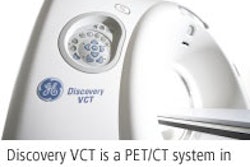Detecting the primary lesion in patients presenting with cancer and an unknown primary is one of the more demanding tasks in diagnostic medical imaging. It's imperative that the primary be identified so that the patient can receive therapy that is adequate for the malignancy. Generally, the most common unknown primary cancers are adenocarcinoma, squamous cell carcinoma, and poorly differentiated carcinoma.
At the recent RSNA conference in Chicago, a pair of presentations put PET/CT to the task of detecting unknown primary cancers. Dr. Mehmet Öksüz from the department of radiology at the Katharinen Hospital in Stuttgart, Germany, investigated the impact of coregistered F-18 FDG-PET/CT imaging on the identification and exact anatomic localization of primary tumors.
"One of the major disadvantages in the past was the lack of exact anatomic localization of F-18 FDG-PET foci, leading to several false-positive findings," Öksüz said.
His research team evaluated 87 consecutive F-18 FDG-PET/CT exams of 43 patients with metastatic cervical adenopathy and 44 patients with extracervical metastases. The scans were conducted on a Discovery LS PET/CT system (GE Healthcare, Chalfont St. Giles, U.K.) one hour after intravenous injection of 360 MBq of F-18 FDG.
According to Öksüz, the group assessed whether a possible primary tumor could be identified by PET or only in the fused images of the PET/CT system. The team also sought to determine if the localization of lesions by CT contributed to therapeutic management.
Öksüz said that a possible primary tumor, determined by F-18 FDG foci, was detected in 35 cases, or 42% of the cohort. In 21 of these cases, nontumor-like lesions were found in the PET/CT images. However, in the remaining 14 cases tumor-like lesions were depicted and histologically identified as five ear, nose, and throat (ENT) tumors; two gastric wall tumors; two cases of thyroid cancer; and one case each of cancer of the esophagus, mandible, breast, ovary, and kidney.
In the 14 patients with primary lesions, nine had disseminated FDG foci, observed Öksüz. He added that in four of these nine patients, the PET/CT images showed potential local complications, which needed additional therapeutic measures. Overall, the researchers' use of PET/CT allowed them to definitely identify 16% (14 of 87 patients) of the primary lesions in cancer of unknown origin.
Öksüz attributed the success to capability of the PET/CT system to precisely localize pathological F-18 FDG uptake via its CT component. He said that this made the histological verification by biopsy easier for the clinicians, particularly in complex anatomic areas such as the ENT region.
In the second RSNA presentation, Dr. Stefano Fanti, from the nuclear medicine department, PET unit, at the Policlinico S. Orsola-Malpighi in Bologna, Italy, presented the results of a study carried out to evaluate the role of FDG-PET/CT for detecting unknown primary cancer in patients with biopsy-proven secondary lesions.
His group's study population consisted of 36 patients, 14 female and 22 male with a mean age of 64.5 years. All the patients had at least one biopsied secondary lesion, a negative physical examination, and negative or inconclusive conventional imaging tests performed on modalities such as CT, ultrasound, or MR.
Fanti said that 15 of these patients had adenocarcinoma; seven patients had a nondefined epithelial carcinoma, six had squamous cell carcinoma, two were determined to have poorly differentiated carcinoma, and one patient each had transitional cell carcinoma, a germ cell tumor, a flat cell tumor, melanoma, a spinocellular carcinoma, and a spindle cell carcinoma.
Each patient underwent a FDG-PET/CT scan on a Discovery LS PET/CT and their results were evaluated by the team, according to Fanti.
The Italian team showed that in 44% of the patients, 17 cases, PET/CT detected the primary occult lesion. This was found in the lung of seven patients, the tongue of two patients, and one each in the testis, tonsil, ovary, biliary system, colon, hypopharynx, tongue, and pharynx of the remaining patients.
In one case, noted Fanti, PET/CT detected an equivocal gastric hypermetabolic area consistent with primary lesion but, as gastroscopy was negative, this finding was not considered definitive.
In 53% of the patients, 18 cases, PET/CT was not conclusive for detecting the primary occult lesion, he said.
Fanti, like Öksüz, attributed the team's success to detecting unknown primary lesions to the utilization of PET/CT.
"This may be due to the correlation of metabolic data provided by the PET scan and the morphological data provided by CT attenuation correction, making it easier for the reader to study anatomically complicated areas such as the head, neck, pelvis, and abdomen," he said.
By Jonathan S. Batchelor
AuntMinnie.com staff writer
December 8, 2005
Related Reading
PET/CT demonstrates high sensitivity in pulmonary nodule staging, December 2, 2005
PET/CT imaging useful in detecting and staging choroidal melanomas, November 8, 2005
Oncologic PET/CT: A primer for radiologists, October 14, 2005
FDG-PET/CT tops other technologies for lymphoma staging, March 23, 2005
PET/CT demonstrates staging strength over PET, CT, and PET plus CT, March 7, 2005
Copyright © 2005 AuntMinnie.com



















